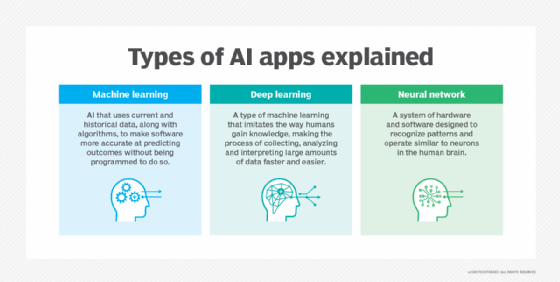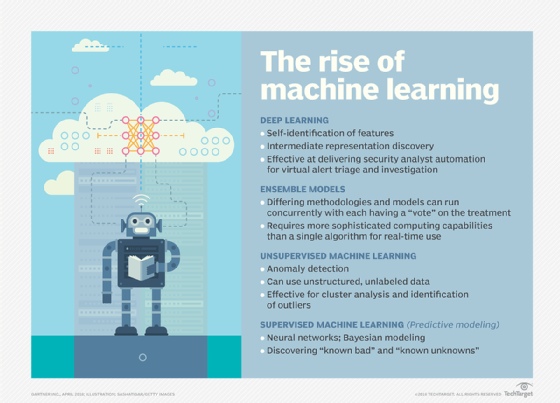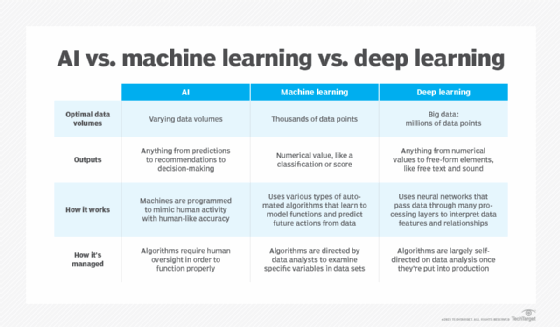AI vs. machine learning vs. deep learning: Key differences
AI terms are often used interchangeably, but they are not the same. Understand the difference between artificial intelligence, machine learning and deep learning.
Artificial intelligence, machine learning and deep learning are popular terms in enterprise IT sometimes used interchangeably, particularly when companies are marketing their products. The terms, however, are not synonymous; there are important distinctions.
AI refers to the simulation of human intelligence by machines. It has an ever-changing definition. As new technologies are created to simulate humans better, the capabilities and limitations of AI are revisited.
Those technologies include machine learning (ML); deep learning, a subset of machine learning; and neural networks, a subset of deep learning.
To better understand the relationship between the different technologies, here is a primer on artificial intelligence vs. machine learning vs. deep learning.
What is artificial intelligence?
The term AI has been around since the 1950s. It depicts our struggle to build machines that can challenge what made humans the dominant lifeform on the planet: our intelligence. However, defining intelligence is tricky because what we perceive as intelligent changes over time.
Early AI systems were rule-based computer programs that could solve somewhat complex problems. Instead of hardcoding every decision the software was supposed to make, the program was divided into a knowledge base and an inference engine. Developers would fill out the knowledge base with facts, and the inference engine would then query those facts to arrive at results.
This type of AI was limited, particularly as it relied heavily on human input. Rule-based systems lack the flexibility to learn and evolve; they are hardly considered intelligent anymore.
Modern AI algorithms can learn from historical data, which makes them usable for an array of applications, such as robotics, self-driving cars, power grid optimization and natural language understanding (NLU).
While AI sometimes yields superhuman performance in these fields, we still have a long way to go before AI can compete with human intelligence.
For now, there is no AI that can learn the way humans do -- that is, with just a few examples. AI needs to be trained on huge amounts of data to understand any topic. Algorithms are still not capable of transferring their understanding of one domain to another. For instance, if we learn a game such as StarCraft, we can play StarCraft II just as quickly. But for AI, it's a whole new world, and it must learn each game from scratch.
Human intelligence also possesses the ability to link meanings. For instance, consider the word human. We can identify humans in pictures and videos, and AI has also gained that capability. But we also know what we should anticipate from humans. We never expect a human to have four wheels and emit carbon like a car. Yet an AI system couldn't surmise this unless trained on enough data.
AI's definition is a moving target. We were amazed when AI algorithms got so sophisticated that they outperformed expert human radiologists. But later we learned about their limitations. That's why we now distinguish between the current narrow AI and the human-level version of AI that we are pursuing: artificial general intelligence (AGI). Every AI application that exists today falls under narrow AI -- also called weak AI -- while AGI is currently only theoretical.

What is machine learning?
Machine learning is a subset of AI; it's one of the AI algorithms we've developed to mimic human intelligence. The other type of AI would be symbolic AI or "good old-fashioned" AI (i.e., rule-based systems using if-then conditions).
Machine learning marks a turning point in AI development. Before ML, we tried to teach computers all the variables of every decision they had to make. This made the process fully visible, and the algorithm could take care of many complex scenarios.
In its most complex form, the AI would traverse several decision branches and find the one with the best results. That is how IBM's Deep Blue was designed to beat Garry Kasparov at chess.
But there are many things we cannot define via rule-based algorithms, like facial recognition. A rule-based system would need to detect different shapes, such as circles, then determine how they are positioned and within what other objects so that it would constitute an eye. Even more daunting for programmers would be how to code for detecting a nose!
Machine learning takes a different approach. It lets the machines learn independently by ingesting vast amounts of data and detecting patterns. Many ML algorithms use statistics formulas and big data to function. It is arguable that our advancements in big data and the vast data we have collected enabled machine learning in the first place.
Some of the ML algorithms used for classification and regression include linear regression, logistic regression, decision trees, support vector machines, naive Bayes, k-nearest neighbors, k-means, random forest and dimensionality reduction algorithms.

What is deep learning?
Deep learning is a subset of machine learning. It still involves letting the machine learn from data, but it marks a milestone in AI's evolution.
Deep learning was developed based on our understanding of neural networks. The idea of building AI based on neural networks has been around since the 1980s, but it wasn't until 2012 that deep learning got real traction. Just like machine learning owes its realization to the vast amount of data we produced, deep learning owes its adoption to the much cheaper computing power that became available as well as advancements in algorithms.
Deep learning enabled much smarter results than were originally possible with machine learning. Consider the face recognition example. To detect a face, what kind of data should we give to the AI, and how should it learn what to look for, given that the only information we can provide is pixel colors?
Deep learning makes use of layers of information processing, each gradually learning more and more complex representations of data. The early layers may learn about colors, the next ones learn about shapes, the following about combinations of those shapes, and finally actual objects. Deep learning demonstrated a breakthrough in object recognition. Its invention quickly advanced AI on several fronts, including NLU.
Deep learning is currently the most sophisticated AI architecture we have developed. Several deep learning algorithms include the following:
- Convolutional neural networks.
- Recurrent neural networks.
- Long short-term memory networks.
- Generative adversarial networks.
- Deep belief networks.
AI vs. machine learning and deep learning
Machine learning and deep learning have clear definitions, whereas what we consider AI changes over time. For instance, optical character recognition used to be considered AI, but it no longer is. However, a deep learning algorithm trained on thousands of handwritings that can convert those to text would be considered AI by today's definition.
Machine learning and deep learning power various applications, including those performing natural language processing, image recognition and classification. These technologies help enterprises augment their workforce by having intelligent machines tackle mundane, repetitive tasks. This frees up employees to focus on creative or high-thinking jobs.

Machine learning vs. deep learning
Deep learning is a type of machine learning that uses complex neural networks to replicate human intelligence. Deep learning and machine learning both typically require advanced hardware to run, like high-end GPUs, as well as access to large amounts of energy. However, deep learning models are different in that they typically learn more quickly and autonomously than machine learning models and can better use large data sets. Applications that use deep learning can include facial recognition systems, self-driving cars and deepfake content.
Machine learning and deep learning both represent great milestones in AI's evolution. There will likely be many others as we head toward current AGI.
Similarities between AI, machine learning and deep learning
Aside from their differences, AI, machine learning and deep learning have the following similarities:
- All three disciplines contribute to the creation of intelligent machines.
- They can more easily solve today's complex problems than older programming methodologies.
- They rely on algorithms to make predictions, discern important patterns in data and carry out tasks.
All three disciplines use data for training models. Models are fed data sets to analyze and learn important information like insights or patterns. In learning from experience, they eventually become high-performance models.
Data quality and diversity are important factors in each form of artificial intelligence. Diverse data sets mitigate inherent biases embedded in the training data that could lead to skewed outputs. High-quality data minimizes errors to ensure models are reliable. Like humans, a model must learn iteratively to improve its performance over time.
Editor's note: David Petersson wrote this feature, which was expanded by Cameron Hashemi-Pour to include information on the similarities shared across AI, ML and deep learning.






